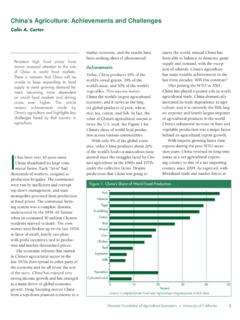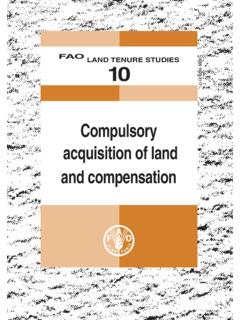Transcription of INCENTIVE SYSTEMS: INCENTIVES, MOTIVATION, AND …
1 1 CONFERENCE PAPER #8 WORKING DRAFT, NOVEMBER 06 INCENTIVE SYSTEMS: incentives , motivation , ANDDEVELOPMENT PERFORMANCEA UNDP CAPACITY DEVELOPMENT RESOURCEC apacity Development GroupBureau for Development PolicyUnited Nations Development ProgrammeNovember 20062 CONTENTS PageACRONYMS AND ABBREVIATIONS3 EXECUTIVE SUMMARY4I. Introduction5II. incentives Strategy in Application7 III. Operational Implications9 ANNEXES221. Annex 1: 3 Case Studies2. Annex 2: Bibliography3 ACRONYMS AND ABBREVIATIONSA cknowledgmentsThis note has been drafted by Thomas Theisohn (Independent Expert) and Tony Land (Independent Expert).Rasheda Selim provided independent editorial comment. It has benefited from a technical review provided byPhilip Courtnadge (UNDP/Regional Bureau for Asia & Pacific), Dele Olowu (Asia Development Bank), andElizabeth Paul (Asia Development Bank).Contact Information:Conference Paper series Production team, Capacity Development Group/BDP, UNDP:Editor.
2 Kanni Wignaraja, Dalita Balassanian, Development BankCAP2015 Capacity 2015 CDGC apacity Development GroupDFIDD epartment for International Development (UK)ECDPME uropean Centre for Development Policy ManagementFAOFood and Agriculture OrganizationGEFG lobal Environment FacilityILOI nternational Labour OrganizationLENCDL earning Network on Capacity DevelopmentOECD/DACO rganisation for Economic Cooperation and Development/DevelopmentAssistance CommitteeUNDGU nited Nations Development GroupUNDPU nited Nations Development ProgrammeUNESCO United Nations Educational, Scientific, and Cultural OrganizationUNEVOC United Nations International Centre for TVETUNICEF United Nations Children FundUSAIDU nited States Agency for International DevelopmentWBIW orld Bank Institute4 EXECUTIVE SUMMARYIt is possible to distinguish factors that have motivational effects from other capacity elements. Some areinternal, others are external to or in the environment of any given system .
3 The question of motivation isinextricably linked with capacity and needs to be analyzed and addressed on all capacity levels: individual,organization and enabling measures, such as salaries, secondary benefits, and intangible rewards, recognition or sanctions havetraditionally been used to motivate employees to increase performance. Motivators may be positive and/ornegative. Reducing dis- incentives or perverse incentives that favour non-conducive behaviour, can often bemore important than inventing new incentives . INCENTIVE systems reside within organizations, their structure,rules, human resource management, opportunities, internal benefits, rewards and sanctions, etc. Whether basedon perception or reality, organizational INCENTIVE systems do have a significant influence on the performance ofindividuals and thus the organization overall. Perhaps the most pervasive structural motivators and incentivesare located at the societal level, such as security, rule of law, investment climate, civil service pay or legislationconducive to civic implications are in terms ways in which incentives and other motivators can be used to mobilisecapacity and to promote development performance.
4 This is done in relation to the following: How to Stimulate Better Performance in the Public Sector How to retain and attract talent on the Global Labour Market How to encourage local service delivery in remote areas How to encourage poor people to claim their rights How to align aid for capacity developmentThe paper suggests throughout potential strategies and tools to pursue. Three of these are highlighted indedicated Reducing Distortionary incentives by Aligning Aid Around National Pay ReformCountries are encouraged to promote transitional arrangements over the medium term that provide a frameworkfor long term pay reform linked to public service reform and that encourage external partners to harmonise andalign their support around a national process. Examples include the Selected Accelerated Salary Enhancement(SASE) scheme in Tanzania (see annexes for case study) and the Cambodian approach of establishing prioritymission groups in key ministries.
5 2. Reducing Demotivation And Valuing Non-Material incentives For Public Service PerformanceEvidence points to a range of demotivating factors besides pay levels and non-material incentives that can havea significant impact on staff motivation and organisational performance. Understanding what makes people andorganisations tick should also be part and parcel of any capacity assessment exercise. A sensible starting pointis to understand and address first and foremost the de-motivating factors. Drivers of Change and Poweranalysis are important tools. Non-material incentives need to be recognized, valued and Conditional Cash Transfers To Strengthen DemandDemand Side Financing (DSF) offers a potential innovation and is an example of one of several demand sideapproaches being explored across various sectors. Conditional cash transfers provide different entry point to thesame set of problems, which may have potential for addressing them from a fresh standpoint.
6 Also with largeramounts of development financing available there is a tendency to deliver through vertical arrangements. Thepotential of using higher volumes of aid for conditional cash transfers to households needs to be seriouslyconsidered within conducive socioeconomic IntroductionMotivation is a critical dimension of capacity, defined as the ability of people, institutions and societies toperform functions, solve problems and set and achieve objectives . incentives and INCENTIVE systems arefundamental to developing capacities and to translating developed capacities into better performance. The focusof this paper is on the incentives and INCENTIVE systems that influence motivation and behaviour of people orlarger system performance for pro-poor action and development outcomes. INCENTIVE systems and motivationsare critical for capacity development as they enable individuals and organisations to perform their functionseffectively, efficiently and motivation , incentives and Capacity concepts, notions and analytical motivation and incentives - definitionsMotivation refers to the initiation, direction, intensity and persistence of behaviour.
7 incentives on the other handare external measures that are designed and established to influence motivation and behaviour of individuals,groups or organizations. INCENTIVE systems or structures are combinations of several more or less coherentincentives. Motivators include purposive incentives in the above sense but also all other external factors, whichimpact upon peoples or organizations motivation . The term motivational system (or structures) can be used torefer to the set of such motivators, more or less persistent in nature, in place at any given can be at different levels individual, organizational and societal. Individuals are driven by their owndesires and moral believes. Individual motivations may be internal or intrinsic motivation (activated from theinside) such as hobbies, caring for children, or voluntary work in society; or they may external or extrinsic (activated from the outside) motivation , which is nurtured from the motivation , distinguished from capacity, refers to the internal motivation of an motivations derive from the fact that people tend to identify with others and have a sense of belonging togroups.
8 Individuals depend on others and thus have a certain loyalty to the groups they belong to. Socialrelations are governed by formal and informal rules. There are three dimensions of societal motivations the firstis a sense of fairness: People, groups and organizations want to feel that they are treated fairly compared topeers or competitors. A second dimension is the existence of criteria and authority that stops unfair dealings andthat encourages fair behaviour. A third is the phenomenon of social pressure. It can be appreciation ordisapproval from superiors, peers or others that the person feels responsible for, for instance any of these levels, there are always internal motivational factors (figure 1). But it should be recognized thatmotivators for improving performance may also come from external sources. For example, for organizations,motivators may reside externally in other organizations and the broader enabling environment.
9 Furthermore,there are interactions of motivations among these three levels individual motivations may enhancemotivation of an organization, but organizations also impact on people, such as their staff or clients. Theyinfluence other organizations such as competing businesses or subordinate offices in the public may in many cases also be the prime entry point for motivating larger societal changes, such as inthe case of a tax authority, a Ministry of Education that decides on curricula, or an anti-corruption agency thatpermeates public and private Security Rule of law Culture Civicengagement etcOrganization History Mission Culture IncentivesIndividual Intrinsic motivation Performance, motivation and capacity analytical linkagesPerceptions and concerns about development performance usually provide the entry point for thinking aboutcapacity issues. Yet, capacity does not automatically translate into improved performance and betterdevelopment results.
10 To illustrate: a car engine may have all the components to run smoothly, but it would still sitidle without fuel and a driver. By the same token, capacities may be in place, but appropriate incentives need tobe present to put them in high gear and in motion toward the desired development destination.( Boesen,2004)There are various ways of conceiving of motivation in relation to capacity. On the individual and organizationallevels, one can easily conceive of motivation being complementary to capacity. On the individual level, capacityto perform is a combination of personal skills and motivation of people. It can be weakened or fuelled from within(such as changing believes or health) or external incentives (measures in the environment that impact onmotivation). Learning, which is at the centre of individual capacity development, is fundamentally a function ofintrinsic voluntary motivation to acquire knowledge and the means to do so.









